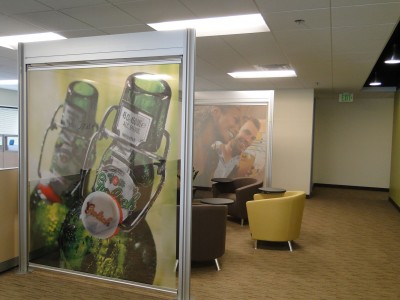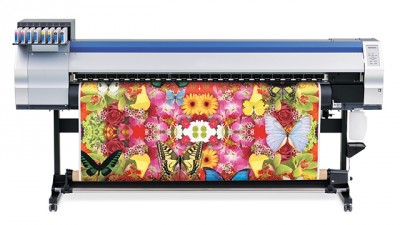
Considering clients’ interior décor needs, the potential market for fabric graphics is much larger than traditional signage alone. Photo courtesy Designtex
Pressing needs
IT Strategies reports inkjet printing has become the most common technology for producing graphics on textiles, achieving more than 45 per cent penetration of the overall soft signage market.
Dye sublimation ink printing options include direct-to-fabric, which uses pretreated textiles and a heat fixation system, and paper transfer, whereby graphics are printed onto paper and then heat-fixated onto untreated textiles.
“In the past, electrostatic (e-stat) printers and screenprinting with disperse dyes were used to produce graphics on textiles,” says Gardino, “but it became easier to produce inkjet inks than e-stat toners and screenprinting proved too expensive and time-consuming. A screen press will cost a million dollars, but you can buy 20 digital presses for the same price. So today, dye-sub is growing and a lot of architectural and point-of-purchase (POP) fabric graphics are produced digitally.”
Hitoshi Ujiie, director of the Center for Excellence of Digital Inkjet Printing for Textiles at Philadelphia University’s School of Design and Engineering, emphasizes the potential for this trend to reach the much-larger industrial textile market, too.
“The textile inkjet printing market is fragmented, with no large single market,” he says. “Outside of signage, the majority of printed textiles are still produced by screenprinting. The missing market segment includes individual artists and designers. So, there is a need for low-end, high-quality digital textile printing systems.”
As these systems become more widely available, even entry-level sign shops are now able to produce fabric graphics. Many of these shops are buying dye sublimation equipment bundled with heat presses. In some cases, the heat press is mounted directly onto the printing system.
“Heat presses and printers are merging, but there are still far more shops doing heat-transfer printing than direct-to-fabric,” says Aurora’s Richardson.

Inkjet printing has become the most common method of producing graphics on textiles, representing more than 45 per cent of the soft signage market. Photo courtesy Mimaki
Other shops are turning to durable aqueous inkjet systems, such as those that use ‘latex’ inks. In any case, the hardware must be suitable for handling and printing textiles, which can be quite different from other substrates.
“The printheads are key and have become faster and easier to maintain,” says Gardino. “You also need a fabric handling system that applies enough tension to the substrate to keep it steady as it goes through the press, preventing it from buckling and the graphic from being distorted.”
The evolution of digital inkjet printing on textiles ramped up in the mid-1990s and only now is yielding true high-speed production presses, from manufacturers like Mimaki, Roland DGA, Durst and Konica Minolta.
“The machines will get better and faster, producing more and brighter colours,” Gardino says. “If you look at what traditional fabric printing is doing now that digital can’t do yet, that’s what clients will ask for in the future, like metallics and white inks.”





